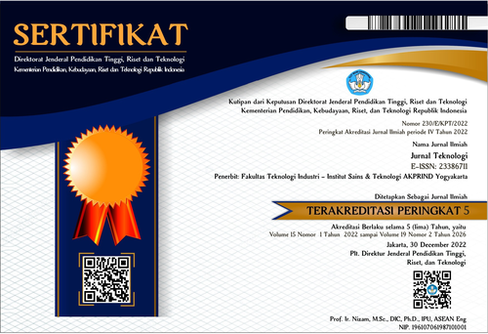Analisis Pemilihan Supplier pada Toko Akbar Telur dengan Menggunakan Metode AHP
DOI:
https://doi.org/10.34151/jurtek.v17i1.4685Keywords:
AHP, egg, supplierAbstract
Eggs are an important source of animal protein as they contain high quality protein and have high biological value. Egg consumption in Indonesia continues to increase every year. This creates opportunities and competition in the egg market, including in Bogor City. In this context, the selection of the right supplier is key in meeting market demand and increasing the existence of sellers. This research was conducted at Shop Akbar Telur in Bogor Suryakencana Market. Data was collected through direct observation and interviews with the shop owner. The AHP method was used to process qualitative and quantitative data to prioritize suppliers based on price, quality and quantity criteria. The results of the analysis using AHP show that price is the highest criterion in selecting egg suppliers at Akbar Telur, followed by quality and quantity. Suppliers with the highest value for each criterion are SJT1 (price), SJT1 (quality), and SJT1 (quantity). The consistency level of criteria comparison is also acceptable. In selecting egg suppliers, the recommended overall priorities are SJT1, SJT2, and SB. The results of this study contribute to the understanding of supplier selection strategies that can improve store efficiency and performance.
Downloads
References
Asyifa, P. N., & Eviyati, R. E. R. 2021. Strategi Peningkatan Jumlah Sayuran Sawi Pada Musim Kemarau di Pasar Jagasatru Kota Cirebon Dengan Menggunakan Metode Analytical Hierarchy Process (AHP). Paradigma Agribisnis, 3(2), 22-31.
Badan Pusat Statistik. 2024. Rata-rata Pengeluaran Perkapita Seminggu Menurut Kelompok Telur dan Susu Per Kabupaten/Kota Tahun 2021-2023. Jakarta (ID): BPS Indonesia.
Farhan, Q. 2017. Analisis Pemilihan Supplier Telur Tetas Dengan Menggunakan Metode Analytical Hierarchy Process di UKM Unggas Pertiwi. Jurnal MATRIK, 18, 39-46.
Kemal, G. F. 2022. Penerapan Strategi Peningkatan Hasil Penjualan di Gudang Jaya Plaza Telur Dengan Menggunakan Metode SWOT dan AHP. Jurnal Teknologika, 12, 295-307.
Mahendra, T. S. 2019. Pemilihan Supplier Kayu Mebel Menggunakan Metode AHP (Analytical Hierarchy Process) di UD. Riyan Pasuruan. Jurnal Valtech, 2(1), 104–109.
Marimin, Taufik D., Suharjito, Syarief H., Ditdit NU., Retno A., Sri M. 2013. Teknik dan Analisis Pengambilan Keputusan Fuzzy dalam Manajemen Rantai Pasok. Bogor: IPB Press.
Oktariza, W., & Sukmawati, A. S2017. Kebijakan Pengentasan Kemiskinan di Kawasan Perdesaan Melalui Usaha Budidaya Perikanan di Kabupaten Malang. Jurnal Sains Terapan: Wahana Informasi dan Alih Teknologi Pertanian, 7(1), 1-11.
Pusat Data dan Informasi Pertanian. 2022. Outlook Komoditas Peternakan Telur Ayam Ras Petelur. Sekretariat Jenderal – Kementerian Pertanian Republik Indonesia.
Rachmawati, N. L., Anggiane Iskandar, Y., Dharmapatni, M. R., Jaariyah, D. A., Gede, D., Ariani, D., Nancy, P., & Layman, D. 2024. Pemilihan Pemasok Telur Menggunakan Metode Analytical Hierarchy Process (Studi Kasus: UD Mega Timur Bajawa, Nusa Tenggara Timur). IKRAITH-TEKNOLOGI, 8(1), 27–37. https://doi.org/10.37817/ikraith-teknologi.v8i1
Supriadi, A. 2018. Analytical Hierarchy Process (AHP) Teknik Penentuan Strategi Daya Saing Kerajinan Bordir. Yogyakarta: Deepublish.
Wulandari, Z., & Arief, I. 2022. Review: Tepung Telur Ayam: Nilai Gizi, Sifat Fungsional dan Manfaat. Jurnal Ilmu Produksi Dan Teknologi Hasil Peternakan, 10(2), 62–68. https://doi.org/10.29244/jipthp.10.2.62-68
Downloads
Published
How to Cite
Issue
Section
License
Copyright (c) 2024 Siti Kumala Zahra

This work is licensed under a Creative Commons Attribution-ShareAlike 4.0 International License.
Jurnal Teknologi provides immediate open access to its content in order of making research freely available to the public to support a global exchange of knowledge. All articles published in this journal are free for everyone to read and download, under licence CC BY SA.
Benefits of open access for the author, include:
- Free access for all users worldwide.
- Authors retain copyright to their work.
- Increased visibility and readership.
- No spatial constraints.




















